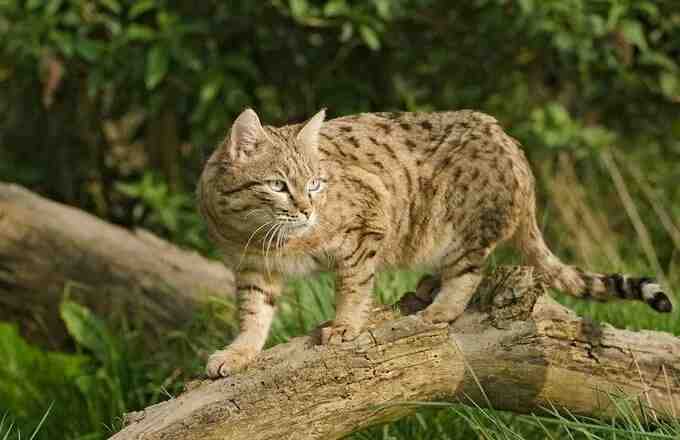Felis silvestris shawiana
IUCN
LCBasic Information
Scientific classification
- name:Felis silvestris shawiana
- Scientific Name:Felis silvestris shawiana,Shaw's Cat,Wild cat, desert spotted cat, bandicoot, Shache spotted wild cat
- Outline:Carnivora
- Family:felidae F.subfamily G.felis
Vital signs
- length:50-70cm
- Weight:About 8kg
- lifetime:About 15 years
Feature
He has a violent temper and dares to confront wolves.
Distribution and Habitat
Distributed in Gansu, western Inner Mongolia, Qinghai, Sichuan, Xinjiang, and Tibet in China.
The steppe cat lives in shrubs and semi-shrub deserts composed of tamarisk, jujube, ephedra, licorice, wild hemp, etc., reed meadows composed of reeds and caltrops, and poplar forests with tamarisk shrubs growing in the forest, as well as grasslands, swamps, and basins or lowland mountain forests below 1,000 meters above sea level. It has strong adaptability to the environment. However, it generally does not enter areas with severe winter cold and snow cover, and its activities tend to be in relatively arid areas.
Appearance
The back of the body is light sandy yellow to light yellowish gray, the color of the fur on the back and sides of the body gradually turns light yellow, and the ventral surface is light yellowish gray. There are many irregularly shaped brown-black patches or horizontal stripes all over the body, and there are slight brown-black tufts on the tips of the ears. There are 5-6 brown-black horizontal stripes on the top of the tail, and the underside of the tail is white. The throat and ventral surface are often pale white to light gray. There are 4 very obvious black bands on the forehead, which are in sharp contrast with the light background; there are usually prominent white to light gray spots on the eyes and nose. There are white or light-colored hairs on the edges of the ears; the hairs on the inside of the ears are light yellowish white. The color of the coat behind the ears ranges from similar to ground color to dark brown. The tail tip is black and there are some black horizontal rin
Details
The steppe cat, also known as Shaw's Cat in English, is a Chinese subspecies of wild cats. It is known as one of the "three most adorable cats in the West" along with the manul and desert cat.

Although the steppe cat looks small, it is indeed very fierce and has a violent temper. It can be said to be a contradictory combination of elegance, laziness and irritability. The steppe cat is agile, good at climbing, sneaking and approaching prey, and suddenly preying. In terms of habits, the steppe cat usually lives alone and has a strong sense of territory. When it grows up, the territory area is about 1 square kilometer. If a cat of the same species enters its territory (except during the breeding season, when it will visit other cats everywhere), it will be attacked fiercely until the winner is decided.
According to the observation of researchers, when the steppe cat meets the prairie wolf, its fur immediately stands up and it dares to show its claws without any fear. As for the scenes of "hand-to-hand combat" between the two, there are very few (probably not seen), because the prairie wolf basically has no reaction when seeing the steppe cat. In addition, according to the investigation of researchers, the steppe cat will try to avoid predators such as foxes and prairie wolves during the day.
The steppe cat is widely distributed in nature with low density, preying on rodents, and has a great effect on suppressing the rampant rodent pests. In the past, only some skins were obtained from purchasing departments in Xinjiang, Gansu and Ningxia provinces in China, but no live ones were seen in the wild, which shows that the population is rare and the current number is difficult to estimate. According to Gao Xingyi (Nowell and Jackson, 1992), the population in northwest China is estimated to be more than 10,000, with an estimated density of 10/100km2 (Cat specialist group, 1992). According to Gao Xingyi (Nowell and Jackson, 1992), the annual purchase volume of steppe cat fur in Xinjiang in the 1980s was 1,500 (Cat Specialist Group, 1992). However, this trade threat has decreased as more and more countries have joined the Convention on International Trade in Endangered Species of Wild Fauna and Flora. There were few zoological surveys and studies in my country before the 1970s, let alone research on steppe cats. According to preliminary statistics in the 1990s, the population of steppe cats in Northwest my country may exceed 10,000, but there is no accurate number at present, so modern academia knows little about the living habits of steppe cats.
The biggest threat currently facing steppe cats is hybridization with domestic cats. According to research by researchers, as human activity areas spread, steppe cats often approach human gathering areas. From an almost untamable state, some have shown a state close to semi-domestication, and have mated and reproduced with domestic cats (stray cats). Due to the existence of a large number of hybrid individuals, the genetic pollution of steppe cats is serious, and the boundary between the two has become very blurred. Therefore, students who keep cats need to be responsible for their cats and not abandon them. If they let them become stray cats, it is purely creating an ecological disaster.
Listed as a protected animal in Appendix II of the Washington Convention on International Trade in Endangered Species of Wild Fauna and Flora (CITES).
Listed in the 2014 IUCN Red List of Threatened Species ver 3.1 - Low Concern (LC).
Listed in the second level of the China National Key Protected Wildlife List.








